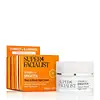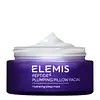What's inside
What's inside
 Key Ingredients
Key Ingredients

 Benefits
Benefits

 Concerns
Concerns

 Ingredients Side-by-side
Ingredients Side-by-side

Water
Skin ConditioningCyclopentasiloxane
EmollientGlycerin
HumectantCetyl Alcohol
EmollientIsostearyl Isostearate
EmollientPolyacrylate-13
Butyrospermum Parkii Butter
Skin ConditioningPentaerythrityl Distearate
EmulsifyingPhenoxyethanol
PreservativePolyisobutene
Sodium Ascorbyl Phosphate
AntioxidantParfum
MaskingSodium Stearoyl Glutamate
CleansingAllantoin
Skin ConditioningBenzoic Acid
MaskingDisodium EDTA
Polysorbate 20
EmulsifyingPropylene Glycol
HumectantSodium Polyacrylate
AbsorbentSorbitan Isostearate
EmulsifyingSolanum Lycopersicum Fruit Extract
AntioxidantDehydroacetic Acid
PreservativeCitric Acid
BufferingLimonene
PerfumingEmblica Officinalis Fruit Extract
Skin ConditioningSodium Hyaluronate
HumectantTocopheryl Acetate
AntioxidantGlyceryl Acrylate/Acrylic Acid Copolymer
HumectantCitral
PerfumingButylphenyl Methylpropional
PerfumingGlycyrrhiza Glabra Root Extract
BleachingHydroxycitronellal
PerfumingHydroxyisohexyl 3-Cyclohexene Carboxaldehyde
MaskingLinalool
PerfumingTromethamine
BufferingWater, Cyclopentasiloxane, Glycerin, Cetyl Alcohol, Isostearyl Isostearate, Polyacrylate-13, Butyrospermum Parkii Butter, Pentaerythrityl Distearate, Phenoxyethanol, Polyisobutene, Sodium Ascorbyl Phosphate, Parfum, Sodium Stearoyl Glutamate, Allantoin, Benzoic Acid, Disodium EDTA, Polysorbate 20, Propylene Glycol, Sodium Polyacrylate, Sorbitan Isostearate, Solanum Lycopersicum Fruit Extract, Dehydroacetic Acid, Citric Acid, Limonene, Emblica Officinalis Fruit Extract, Sodium Hyaluronate, Tocopheryl Acetate, Glyceryl Acrylate/Acrylic Acid Copolymer, Citral, Butylphenyl Methylpropional, Glycyrrhiza Glabra Root Extract, Hydroxycitronellal, Hydroxyisohexyl 3-Cyclohexene Carboxaldehyde, Linalool, Tromethamine
Water
Skin ConditioningPEG-8
HumectantDicaprylyl Carbonate
EmollientGlycerin
HumectantDiheptyl Succinate
EmollientCapryloyl Glycerin/Sebacic Acid Copolymer
Skin ConditioningSodium Polyacrylate
AbsorbentPhenoxyethanol
PreservativeHydroxyacetophenone
AntioxidantParfum
MaskingDisodium EDTA
Chondrus Crispus Extract
Skin ConditioningBuglossoides Arvensis Seed Oil
EmollientBenzyl Benzoate
AntimicrobialGlyceryl Acrylate/Acrylic Acid Copolymer
HumectantBenzyl Alcohol
PerfumingLinalool
PerfumingMaltodextrin
AbsorbentLimonene
PerfumingLithothamnion Calcareum Extract
Skin ConditioningTocopherol
AntioxidantVeronica Officinalis Flower/Leaf/Stem Extract
AstringentHexyl Cinnamal
PerfumingDehydroacetic Acid
PreservativeNyctanthes Arbor-Tristis Flower Extract
Skin ConditioningCananga Odorata Flower Oil
MaskingCitrus Aurantium Dulcis Peel Oil
MaskingMyristica Fragrans Kernel Oil
MaskingGardenia Florida Fruit Extract
Skin ConditioningHydrolyzed Yeast Protein
Skin ConditioningSodium Benzoate
MaskingCitric Acid
BufferingCitrus Aurantium Amara Leaf/Twig Oil
MaskingCitrus Aurantium Amara Peel Oil
Skin ConditioningCoriandrum Sativum Fruit Oil
MaskingBenzoic Acid
MaskingEthylhexylglycerin
Skin ConditioningWater, PEG-8, Dicaprylyl Carbonate, Glycerin, Diheptyl Succinate, Capryloyl Glycerin/Sebacic Acid Copolymer, Sodium Polyacrylate, Phenoxyethanol, Hydroxyacetophenone, Parfum, Disodium EDTA, Chondrus Crispus Extract, Buglossoides Arvensis Seed Oil, Benzyl Benzoate, Glyceryl Acrylate/Acrylic Acid Copolymer, Benzyl Alcohol, Linalool, Maltodextrin, Limonene, Lithothamnion Calcareum Extract, Tocopherol, Veronica Officinalis Flower/Leaf/Stem Extract, Hexyl Cinnamal, Dehydroacetic Acid, Nyctanthes Arbor-Tristis Flower Extract, Cananga Odorata Flower Oil, Citrus Aurantium Dulcis Peel Oil, Myristica Fragrans Kernel Oil, Gardenia Florida Fruit Extract, Hydrolyzed Yeast Protein, Sodium Benzoate, Citric Acid, Citrus Aurantium Amara Leaf/Twig Oil, Citrus Aurantium Amara Peel Oil, Coriandrum Sativum Fruit Oil, Benzoic Acid, Ethylhexylglycerin
Ingredients Explained
These ingredients are found in both products.
Ingredients higher up in an ingredient list are typically present in a larger amount.
Benzoic Acid is used to preserve and adjust the pH of products.
The antimicrobial property of Benzoic Acid helps elongate a product's shelf life. Its main role is to reduce fungi growth and is not found to be effective at fighting bacteria. Therefore Benzoic Acid is always added along with other preservatives.
In its pure form, Benzoic Acid looks like a white crystalline solid. It has slight solubility in water.
The name of Benzoic Acid comes from gum benzoin, which used to be the sole source of deriving this ingredient. Benzoic Acid is the most simple aromatic carboxylic acid.
Benzoic Acid is naturally occuring in strawberries, mustard, cinnamon, and cloves. It has a slight scent but is not considered to be a fragrance.
Learn more about Benzoic AcidCitric Acid is an alpha hydroxy acid (AHA) naturally found in citrus fruits like oranges, lemons, and limes.
Like other AHAs, citric acid can exfoliate skin by breaking down the bonds that hold dead skin cells together. This helps reveal smoother and brighter skin underneath.
However, this exfoliating effect only happens at high concentrations (20%) which can be hard to find in cosmetic products.
Due to this, citric acid is usually included in small amounts as a pH adjuster. This helps keep products slightly more acidic and compatible with skin's natural pH.
In skincare formulas, citric acid can:
While it can provide some skin benefits, research shows lactic acid and glycolic acid are generally more effective and less irritating exfoliants.
Most citric acid used in skincare today is made by fermenting sugars (usually from molasses). This synthetic version is identical to the natural citrus form but easier to stabilize and use in formulations.
Read more about some other popular AHA's here:
Learn more about Citric AcidDehydroacetic Acid is fungicide and bactericide. It is used as a preservative in cosmetics. Preservatives help elongate the shelf life of a product.
Dehydroacetic Acid is not soluble in water.
Disodium EDTA plays a role in making products more stable by aiding other preservatives.
It is a chelating agent, meaning it neutralizes metal ions that may be found in a product.
Disodium EDTA is a salt of edetic acid and is found to be safe in cosmetic ingredients.
Learn more about Disodium EDTAGlycerin is already naturally found in your skin. It helps moisturize and protect your skin.
A study from 2016 found glycerin to be more effective as a humectant than AHAs and hyaluronic acid.
As a humectant, it helps the skin stay hydrated by pulling moisture to your skin. The low molecular weight of glycerin allows it to pull moisture into the deeper layers of your skin.
Hydrated skin improves your skin barrier; Your skin barrier helps protect against irritants and bacteria.
Glycerin has also been found to have antimicrobial and antiviral properties. Due to these properties, glycerin is often used in wound and burn treatments.
In cosmetics, glycerin is usually derived from plants such as soybean or palm. However, it can also be sourced from animals, such as tallow or animal fat.
This ingredient is organic, colorless, odorless, and non-toxic.
Glycerin is the name for this ingredient in American English. British English uses Glycerol/Glycerine.
Learn more about GlycerinGlyceryl Acrylate/Acrylic Acid Copolymer is made up of glycerin and polyacrylic acid. It helps hydrate your skin as a humectant.
This ingredient forms a hydrogel that delivers moisturizing, water-based ingredients to the skin. It is also used to thicken a product and to give it a smooth texture.
Acrylic acid itself is toxic, but the polymer form (this ingredient) is too large to penetrate skin, making it non-toxic.
Learn more about Glyceryl Acrylate/Acrylic Acid CopolymerLimonene is a fragrance that adds scent and taste to a formulation.
It's found in the peel oil of citrus fruits and other plants such as lavender and eucalyptus. The scent of limonene is generally described as "sweet citrus".
Limonene acts as an antioxidant, meaning it helps neutralize free radicals.
When exposed to air, oxidized limonene may sensitize the skin. Because of this, limonene is often avoided by people with sensitive skin.
The term 'fragrance' is not regulated in many countries. In many cases, it is up to the brand to define this term. For instance, many brands choose to label themselves as "fragrance-free" because they are not using synthetic fragrances. However, their products may still contain ingredients such as essential oils that are considered a fragrance.
Learn more about LimoneneLinalool is a fragrance and helps add scent to products. It's derived from common plants such as cinnamon, mint, citrus, and lavender.
Like Limonene, this ingredient oxidizes when exposed to air. Oxidized linalool can cause allergies and skin sensitivity.
This ingredient has a scent that is floral, spicy tropical, and citrus-like.
Learn more about LinaloolParfum is a catch-all term for an ingredient or more that is used to give a scent to products.
Also called "fragrance", this ingredient can be a blend of hundreds of chemicals or plant oils. This means every product with "fragrance" or "parfum" in the ingredients list is a different mixture.
For instance, Habanolide is a proprietary trade name for a specific aroma chemical. When used as a fragrance ingredient in cosmetics, most aroma chemicals fall under the broad labeling category of “FRAGRANCE” or “PARFUM” according to EU and US regulations.
The term 'parfum' or 'fragrance' is not regulated in many countries. In many cases, it is up to the brand to define this term.
For instance, many brands choose to label themselves as "fragrance-free" because they are not using synthetic fragrances. However, their products may still contain ingredients such as essential oils that are considered a fragrance by INCI standards.
One example is Calendula flower extract. Calendula is an essential oil that still imparts a scent or 'fragrance'.
Depending on the blend, the ingredients in the mixture can cause allergies and sensitivities on the skin. Some ingredients that are known EU allergens include linalool and citronellol.
Parfum can also be used to mask or cover an unpleasant scent.
The bottom line is: not all fragrances/parfum/ingredients are created equally. If you are worried about fragrances, we recommend taking a closer look at an ingredient. And of course, we always recommend speaking with a professional.
Learn more about ParfumPhenoxyethanol is a preservative that has germicide, antimicrobial, and aromatic properties. Studies show that phenoxyethanol can prevent microbial growth. By itself, it has a scent that is similar to that of a rose.
It's often used in formulations along with Caprylyl Glycol to preserve the shelf life of products.
Sodium Polyacrylate is the sodium salt of polyacrylic acid. It is used as an absorber, emollient, and stabilizer.
This ingredient is a super-absorbent polymer - meaning it can absorb 100 to 1000 times its mass in water. As an emollient, Sodium Polyacrylate helps soften and soothe skin. Emollients work by creating a barrier to trap moisture in. This helps keep your skin hydrated.
Water. It's the most common cosmetic ingredient of all. You'll usually see it at the top of ingredient lists, meaning that it makes up the largest part of the product.
So why is it so popular? Water most often acts as a solvent - this means that it helps dissolve other ingredients into the formulation.
You'll also recognize water as that liquid we all need to stay alive. If you see this, drink a glass of water. Stay hydrated!
Learn more about Water